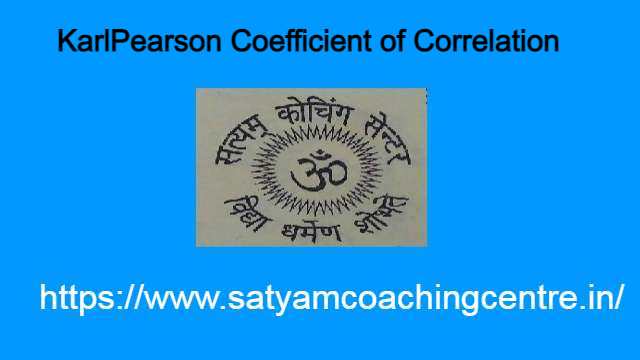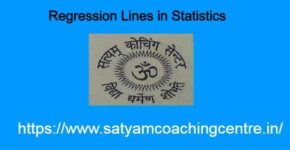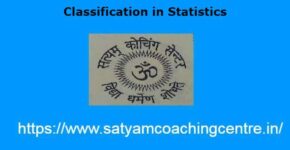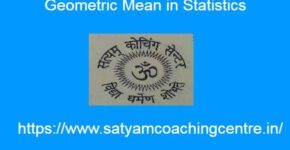KarlPearson Coefficient of Correlation
1.कार्ल पियर्सन का सहसम्बन्ध गुणांक (KarlPearson Coefficient of Correlation),कार्ल पियर्सन रीति से सहसम्बन्ध गुणांक (Coefficient of Correlation by Karl Pearson Method):
कार्ल पियर्सन का सहसम्बन्ध गुणांक (KarlPearson Coefficient of Correlation) सहविचरण (covariation) का ही गुणांक (सापेक्ष माप) है।सहविचरण एक निरपेक्ष माप है।इसे गुणांक में परिवर्तित करने के लिए दोनों श्रेणियों के प्रमाप विचलनों (Standard Deviations) के गुणनफल का भाग दे दिया जाता है।इस प्रकार उपलब्ध अनुपात ही सहसम्बन्ध गुणांक कहलाता है।
आपको यह जानकारी रोचक व ज्ञानवर्धक लगे तो अपने मित्रों के साथ इस गणित के आर्टिकल को शेयर करें।यदि आप इस वेबसाइट पर पहली बार आए हैं तो वेबसाइट को फॉलो करें और ईमेल सब्सक्रिप्शन को भी फॉलो करें।जिससे नए आर्टिकल का नोटिफिकेशन आपको मिल सके । यदि आर्टिकल पसन्द आए तो अपने मित्रों के साथ शेयर और लाईक करें जिससे वे भी लाभ उठाए । आपकी कोई समस्या हो या कोई सुझाव देना चाहते हैं तो कमेंट करके बताएं।इस आर्टिकल को पूरा पढ़ें।
Also Read This Article:-Correlation by Karl Pearson Method
2.कार्ल पियर्सन का सहसम्बन्ध गुणांक पर आधारित उदाहरण (Examples Based on KarlPearson Coefficient of Correlation):
Example:16.निम्नलिखित सारणी में किसी एक वर्ष की सैकण्ड्री परीक्षा का परिणाम प्रस्तुत है।कार्ल पियर्सन का सहसम्बन्ध गुणांक तथा सम्भाव्य विभ्रम का परिकलन कीजिए।बतालाइए कि क्या आयु तथा असफलता सहसम्बन्धित हैंः
(The following table gives the result of secondary examination held in 2006.Calculate Karl Pearson’s Coefficient of Correlation and its probable error.Say,if age related with percentage of failures):
| Age in Years | Pass % |
| 13-14 | 61 |
| 14-15 | 60 |
| 15-16 | 57 |
| 16-17 | 58 |
| 17-18 | 64 |
| 18-19 | 70 |
| 19-20 | 52 |
| 20-21 | 56 |
| 21-22 | 50 |
Solution:Calculation Table of Karl Pearson’s Coefficient of Correlation
| Age in | M.V. | dx | d^2 x | pass % | failures | dy | d^2 y | |
| Years(X) | X | A=17.5 | Y | A=36 | dxdy | |||
| 13-14 | 13.5 | -4 | 16 | 61 | 39 | 3 | 9 | -12 |
| 14-15 | 14.5 | -3 | 9 | 60 | 40 | 4 | 16 | -12 |
| 15-16 | 15.5 | -2 | 4 | 57 | 43 | 7 | 49 | -14 |
| 16-17 | 16.5 | -1 | 1 | 58 | 42 | 6 | 36 | -6 |
| 17-18 | 17.5 | 0 | 0 | 64 | 36 | 0 | 0 | 0 |
| 18-19 | 18.5 | 1 | 1 | 70 | 30 | -6 | 36 | -6 |
| 19-20 | 19.5 | 2 | 4 | 52 | 48 | 12 | 144 | 24 |
| 20-21 | 20.5 | 3 | 9 | 56 | 44 | 8 | 64 | 24 |
| 21-22 | 21.5 | 4 | 16 | 50 | 50 | 14 | 196 | 56 |
| Total | 0 | 60 | 48 | 550 | 54 |
Correlation Between Age and percentage of failures
r=\frac{\Sigma d x d y \cdot N-\left(\Sigma d x \cdot \Sigma d y\right)}{\sqrt{\left\{\Sigma d^2 x \cdot N-\left(\Sigma d x\right)^2\right\}\left\{\Sigma d^2 y \cdot N-(\Sigma d y)^2\right\}}} \\=\frac{54 \times 9-(0)(48)}{\sqrt{\left\{60 \times 9-(0)^2\right\}\left\{550 \times 9-(48)^2\right\}}} \\=\frac{54 \times 9}{\sqrt{540 \times(4950-2304)}} \\ =\frac{486}{\sqrt{540 \times 2646}} \\ =\frac{4 86}{\sqrt{1428840}} \\ =\frac{486}{1195.340956} \\ =0.406578 \\ r \approx+0.4065 \\ \text { Probable Error }=0.6745 \times \frac{1-r^2}{\sqrt{N}} \\ \Rightarrow \text{ P.E. of r }=\frac{0.6745 \times (1-0.4065)^2}{\sqrt{9}} \\ =\frac{0.6745(1-0.20839225)}{3} \\ =\frac{0.6745 \times 0.79160775}{3} \\ =\frac{0.533939427}{3} \\ =0.177979809 \\ \Rightarrow \text{ P.E. of r } \approx 0.2
Example:17.निम्नलिखित सारणी में 2006 वर्ष में हुई बी. काॅम. परीक्षा का परिणाम प्रस्तुत है,सहसम्बन्ध गुणांक तथा सम्भाव्य विभ्रम का परिकलन कीजिए।आप अपने परिणामों से बतालाइए कि क्या आयु एवं परीक्षा में सफलता सम्बन्धित हैं?
(The following table gives the result of the B. Com. Examination held in 2006.Calculate the coefficient of correlation and estimate the probable error.From your result can you definitely assert that age and passing of examination are correlated?)
| Age in Years | Pass Percentage |
| 17 | 61 |
| 18 | 60 |
| 19 | 57 |
| 20 | 66 |
| 21 | 64 |
| 22 | 61 |
| 23 | 51 |
Solution:Calculation Table of Karl Pearson’s Coefficient of Correlation
| Age in | dx | d^2 x | pass | dy | d^2 y | dxdy |
| Years | A=20 | percentage(Y) | A=66 | |||
| 17 | -3 | 9 | 61 | -5 | 25 | 15 |
| 18 | -2 | 4 | 60 | -6 | 36 | 12 |
| 19 | -1 | 1 | 57 | -9 | 81 | 9 |
| 20 | 0 | 0 | 66 | 0 | 0 | 0 |
| 21 | 1 | 1 | 64 | -2 | 4 | -2 |
| 22 | 2 | 4 | 61 | -5 | 25 | -10 |
| 23 | 3 | 9 | 51 | -15 | 225 | -45 |
| -42 | 396 | -21 |
r=\frac{\Sigma d x d y \cdot N-\left(\Sigma d x \cdot \Sigma d y\right)}{\sqrt{\left\{\Sigma d^{2}x \cdot N-(\Sigma dx)^2\right\}\left\{\Sigma d^2 y \cdot N-\left(\Sigma d y\right)^2\right\}}} \\ =\frac{-21 \times 7-(0)(-42)}{\sqrt{\left\{28 \times 7-(0)^2\right\}\left\{396 \times 7-(-42)^2\right\}}} \\ =\frac{-147}{\sqrt{196 \times\left(2772-1764\right)}} \\ =\frac{-147}{\sqrt{196 \times 1008}} \\ =\frac{-147}{14 \times 31.7490} \\ =\frac{-147}{444.486} \\ =-0.330719 \\ r \approx-0.3307 \\ \text { P.E. of r }=0.6745 \times \frac{\left(1-r^2\right)}{\sqrt{N}} \\ =0.6745 \times \frac{\left[1-(-0.3307)^2\right]}{\sqrt{7}} \\ =\frac{0.6745 \times[1-0.109362]}{2.645751} \\ =\frac{0.6745 \times 0.890638}{2.645751} \\ =\frac{0.600735331}{2.645751} \\ =0.22705 \\ \text { P.E. of r } \approx 0.23
Example:18.From the following data find coefficient of correlation between rainfall and total production:
| Rainfall inches | Rabi production | Kharif production |
| 20 | 15 | 15 |
| 22 | 18 | 17 |
| 24 | 20 | 20 |
| 26 | 32 | 18 |
| 28 | 40 | 20 |
| 30 | 39 | 21 |
| 32 | 40 | 15 |
Solution:Calculation Table of Karl Pearson’s Coefficient of Correlation
| Rainfall | dx | d^2 x | Rabi | kharif |
| inches(X) | A=26 | production | production | |
| 20 | -6 | 36 | 15 | 15 |
| 22 | -4 | 16 | 18 | 17 |
| 24 | -2 | 4 | 20 | 20 |
| 26 | 0 | 0 | 32 | 18 |
| 28 | 2 | 4 | 40 | 20 |
| 30 | 4 | 16 | 39 | 21 |
| 32 | 6 | 36 | 40 | 15 |
| Total | 0 | 112 |
| Total | dy | d^2 y | |
| production | A=50 | dxdy | |
| 30 | -20 | 400 | 120 |
| 35 | -15 | 225 | 60 |
| 40 | -10 | 100 | 20 |
| 50 | 0 | 0 | 0 |
| 60 | 10 | 100 | 20 |
| 60 | 10 | 100 | 40 |
| 55 | 5 | 25 | 30 |
| -20 | 950 | 290 |
Example:19.निम्नलिखित छात्रों की आयु तथा खेलकूद में रुचि के मध्य सहसम्बन्ध गुणांक ज्ञात कीजिएः
(Find coefficient of correlation between age and playing habit of the following students):
| Age | No. of Students | playing habit |
| 12 | 500 | 400 |
| 14 | 400 | 300 |
| 16 | 300 | 180 |
| 18 | 240 | 96 |
| 20 | 200 | 60 |
| 22 | 160 | 24 |
Solution:Calculation of Percentage of Playing Habit of Students
| Age | No. of | playing habits | percenatge of playing |
| Students | of students | habits of students | |
| 12 | 500 | 400 | 80 |
| 14 | 400 | 300 | 75 |
| 16 | 300 | 180 | 60 |
| 18 | 240 | 96 | 40 |
| 20 | 200 | 60 | 30 |
| 22 | 160 | 24 | 15 |
Calculation Table of Karl Pearson’s Coefficient of Correlation
| Age | dx | d^2 x | Percentage of | dy | d^2 y | |
| X | A=18 | playing | A=40 | dxdy | ||
| 12 | -6 | 36 | 80 | 40 | 1600 | -240 |
| 14 | -4 | 16 | 75 | 35 | 1225 | -140 |
| 16 | -2 | 4 | 60 | 20 | 400 | -40 |
| 18 | 0 | 0 | 40 | 0 | 0 | 0 |
| 20 | 2 | 4 | 30 | -10 | 100 | -20 |
| 22 | 4 | 16 | 15 | -25 | 625 | -100 |
| Total | 3950 | -540 |
r=\frac{\Sigma dx dy \cdot N-(\Sigma d x \cdot \Sigma d y)}{\sqrt{\left\{\Sigma d^2 x \cdot N-(\Sigma d x)^2\right\}\left\{\Sigma d^2 y \cdot N-(\Sigma d y)^2\right\}}} \\ =-\frac{-540 \times 6-(-6)(60)}{\left\{376 \times 6-(-6)^2\right\}\left\{3950 \times 6-(60)^2\right\}} \\ =\frac{-3240+360}{\sqrt{(456-36)(23700-3600)}} \\ =\frac{-2880}{\sqrt{420 \times 20100}} \\ =\frac{-2880}{\sqrt{8442000}} \\ =\frac{-2880}{2905.5112003} \\ =-0.991219 \\ r \approx -0.99
Example:20.निम्नलिखित सारणी श्रमिकों का वितरण,उनकी प्रतिदिन मजदूरी एवं उनमें नियमित शराब पीने की आदत को प्रदर्शित करती है।मजदूरी एवं पीने की आदत के मध्य सहसम्बन्ध गुणांक ज्ञात कीजिएः
(From the following table giving the distribution of workers and also regular drinkers among them according to daily wage groups,find the correlation between wages and drinking habit):
| wages(Rs) | workers | Drinkers |
| 15-16 | 300 | 225 |
| 16-17 | 405 | 243 |
| 17-18 | 510 | 255 |
| 18-19 | 540 | 270 |
| 19-20 | 600 | 270 |
| 20-21 | 450 | 180 |
Solution:Calculation of Percentage of Drinkers
| Wages(Rs.) | Workers | Drinkers | Percentage of Drinkers |
| 15-16 | 300 | 225 | 75 |
| 16-17 | 405 | 243 | 60 |
| 17-18 | 510 | 255 | 50 |
| 18-19 | 540 | 270 | 50 |
| 19-20 | 600 | 270 | 45 |
| 20-21 | 450 | 180 | 40 |
Calculation Table of Karl Pearson’s Coefficient of Correlation
| Wages(Rs.) | M.V. | dx | d^2 x | percentage | dy | d^2 y | |
| (X) | A=18.5 | of Drinkers | A=50 | dxdy | |||
| 15-16 | 15.5 | -3 | 9 | 75 | +25 | 625 | -75 |
| 16-17 | 16.5 | -2 | 4 | 60 | +10 | 100 | -20 |
| 17-18 | 17.5 | -1 | 1 | 50 | 0 | 0 | 0 |
| 18-19 | 18.5 | 0 | 0 | 50 | 0 | 0 | 0 |
| 19-20 | 19.5 | 1 | 1 | 45 | -5 | 25 | -5 |
| 20-21 | 20.5 | 2 | 4 | 40 | -10 | 100 | -20 |
| Total | -3 | 19 | 20 | 850 | -120 |
r=\frac{\Sigma d x d y \cdot N-(\Sigma d x \cdot \Sigma d y)}{\sqrt{\left\{\Sigma d^2 x \cdot N-(\Sigma d x)^2\right\}\left\{\Sigma d^2 y \cdot N-(\Sigma d y)^2\right\}}} \\ =\frac{-120 \times 6-(-3)(20)}{\sqrt{\left\{19 \times 6-(-3)^2\right\}\left\{850 \times 6-(20)^2\right\}}} \\ =\frac{-720+60}{\sqrt{(114-9)(5100-400)}} \\ =\frac{-660}{\sqrt{105 \times 4700}} \\ =\frac{-660}{\sqrt{493500}} \\ =\frac{-660}{702.4955516} \\ =-0.9395077 \\ r \approx-0.9395
Example:21.निमनलिखित सूचनाओं के आधार पर जनसंख्या घनत्व और मृत्यु दर में सहसम्बन्ध,यदि कोई हो तो बतलाइएः
(From the following data,find out if there is relationship between density of population and death rate):
| District | Area sq. kms | population | No. of deaths |
| A | 150 | 30000 | 300 |
| B | 180 | 90000 | 1440 |
| C | 100 | 40000 | 560 |
| D | 60 | 42000 | 840 |
| E | 120 | 72000 | 1224 |
| F | 80 | 24000 | 312 |
Solution:Calculation Table of Density of Population and Death Rate
| District | Area sq. kms | population | No. of Deaths | Density | death Rate |
| (1) | (2) | (3) | (4) | (5) | (6) |
| A | 150 | 30000 | 300 | 200 | 10 |
| B | 180 | 90000 | 1440 | 500 | 16 |
| C | 100 | 40000 | 560 | 400 | 14 |
| D | 60 | 42000 | 840 | 700 | 20 |
| E | 120 | 72000 | 1224 | 600 | 17 |
| F | 80 | 24000 | 312 | 300 | 13 |
टिप्पणी (Note):सवाल को हल करने के पूर्व जनसंख्या घनत्व तथा मृत्यु दर ज्ञात करना होगाः
जनसंख्या घनत्व=\frac{\text{ जनसंख्या }}{\text{ क्षेत्रफल }}
A जिले का जनसंख्या घनत्व=\frac{30000}{150}=200
इसी प्रकार अन्य जिलों का जनसंख्या घनत्व ज्ञात करेंगे।
मृत्यु दर=\frac{ \text{ No. of Death}}{\text{Population}} ]\times 1000=10 ‰
A जिले की मृत्यु दर=\frac{1440 \times 1000}{90000} \\ =16 ‰
इसी प्रकार अन्य जिलों की मृत्यु दर ज्ञात करेंगे।
Calculation Table of Karl Pearson’s Coefficient of Correlation
| Density | dx | d^2 x | Death Rate | dy | d^2 y | dxdy |
| (X) | A=1700 | Y | ||||
| 200 | -500 | 250000 | 10 | -10 | 100 | 5000 |
| 500 | -200 | 40000 | 16 | -4 | 16 | 800 |
| 400 | -300 | 90000 | 14 | -6 | 36 | 1800 |
| 700 | 0 | 0 | 20 | 0 | 0 | 0 |
| 600 | -100 | 10000 | 17 | -3 | 9 | 300 |
| 300 | -400 | 160000 | 13 | -7 | 49 | 2800 |
| Total | -1500 | 550000 | -30 | 210 | 10700 |
r=\frac{\Sigma d x d y \cdot N-(\Sigma d x \cdot \Sigma d y)}{\sqrt{\left\{\Sigma d^2 x \cdot N-(\Sigma d x)^2\right\}\left\{\Sigma d^{2}y \cdot N-(\Sigma d y)^2\right\}}} \\ =\frac{10700 \times 6-(-1500)(-30)}{\sqrt{\left\{550000 \times 6-(-1500)^2\right\}\left\{210 \times 6-(-30)^2\right\}}} \\ =\frac{64200-45000}{\sqrt{(3300000-2250000)(1260-900)}} \\ =\frac{19200}{\sqrt{1050000 \times 360}} \\ =\frac{19200}{\sqrt{378000000}} \\ =\frac{19200}{19442.2221} \\=0.987541 \\ r \approx+0.9875
Example:22.बीमारी एवं मृत्यु के मध्य सहसम्बन्ध गुणांक ज्ञात कीजिएः
(Calculate coefficient of correlation between sickness and death):
| Age Group (आयु वर्ग) | No. of Persons (व्यक्तियों की संख्या) | No. of Sick Persons (बीमार व्यक्तियों की संख्या) | No. of Deaths (मृतकों की संख्या) |
| 0-10 | 1000 | 400 | 200 |
| 10-30 | 5000 | 1000 | 250 |
| 30-35 | 8000 | 2000 | 800 |
| 35-50 | 10000 | 7000 | 5000 |
| 50 and above | 2000 | 1600 | 1200 |
Solution:Calculation Table of Percentage of Sick Persons and Percentage of Death
| No. of persons | No. of sick persons | No. of Deaths | Percentage of | Percentage of |
| Sick persons | Deaths | |||
| 1000 | 400 | 200 | 40 | 20 |
| 5000 | 1000 | 250 | 20 | 5 |
| 8000 | 2000 | 800 | 25 | 10 |
| 10000 | 7000 | 5000 | 70 | 50 |
| 2000 | 1600 | 1200 | 80 | 60 |
Percentage of sick persons=\frac{\text { No. of sick persons }}{\text {No. of persons }} \times 100
percentage of Deaths=\frac{\text{ No. of Deaths }}{\text{ No. of Persons }} \times 100
Calculation Table of Karl Pearson’s Coefficient of Correlation
| Percenatge of | dx | d^2 x | percentage of | dy | d^2 y | |
| Sick persons | A=25 | Deaths | A=10 | dxdy | ||
| 40 | 15 | 225 | 20 | 10 | 100 | 150 |
| 20 | -5 | 25 | 5 | -5 | 25 | 25 |
| 25 | 0 | 0 | 10 | 0 | 0 | 0 |
| 70 | 45 | 2025 | 50 | 40 | 1600 | 1800 |
| 80 | 55 | 3025 | 60 | 50 | 2500 | 2750 |
| Total | 110 | 5300 | 95 | 4225 | 4725 |
उपर्युक्त प्रश्नों के उत्तर द्वारा कार्ल पियर्सन का सहसम्बन्ध गुणांक (KarlPearson Coefficient of Correlation),कार्ल पियर्सन रीति से सहसम्बन्ध गुणांक (Coefficient of Correlation by Karl Pearson Method) के बारे में ओर अधिक जानकारी प्राप्त कर सकते हैं।
3.कार्ल पियर्सन का सहसम्बन्ध गुणांक पर आधारित सवाल (Questions Based on KarlPearson Coefficient of Correlation):
(1.)निम्नलिखित आँकड़ों से कार्ल पियर्सन का सहसम्बन्ध गुणांक ज्ञात कीजिएः
(Calculate Karl Pearson’s coefficient of correlation from the following data):
| Age of Husband(years) | Age of Wife(years) |
| 24 | 18 |
| 27 | 20 |
| 28 | 22 |
| 28 | 25 |
| 29 | 22 |
| 30 | 28 |
| 32 | 28 |
| 33 | 30 |
| 35 | 27 |
| 35 | 30 |
| 40 | 22 |
(2.)पतियों और पत्नियों की निम्नांकित आयु के बीच सहसम्बन्ध गुणांक ज्ञात कीजिए और उसका निर्वचन भी कीजिएः
(Find r, between the following ages of husbands and wives and also interpret it):
| 24 | 20 |
| 32 | 27 |
| 24 | 24 |
| 26 | 24 |
| 34 | 27 |
| 28 | 24 |
| 30 | 32 |
| 30 | 25 |
| 35 | 31 |
| 37 | 36 |
उत्तर (Answers):(1.)r=+0.555 Excluding last pair r=+0.881
(2.)r=+0.83,p.e.=0.065
उपर्युक्त प्रश्नों के उत्तर द्वारा कार्ल पियर्सन का सहसम्बन्ध गुणांक (KarlPearson Coefficient of Correlation),कार्ल पियर्सन रीति से सहसम्बन्ध गुणांक (Coefficient of Correlation by Karl Pearson Method) के बारे में ओर अधिक जानकारी प्राप्त कर सकते हैं।
Also Read This Article:-Karl Pearson Correlation Coefficient
4.कार्ल पियर्सन का सहसम्बन्ध गुणांक (Frequently Asked Questions Related to KarlPearson Coefficient of Correlation),कार्ल पियर्सन रीति से सहसम्बन्ध गुणांक (Coefficient of Correlation by Karl Pearson Method) से सम्बन्धित अक्सर पूछे जाने वाले प्रश्न:
प्रश्न:1.सहसम्बन्ध गुणांक की परिभाषा दीजिए। (Give a Definition of Coefficient of Correlation):
उत्तरःप्रो. किंग के मतानुसार दो श्रेणियों अथवा समूहों के मध्य कार्य-कारण सम्बन्ध को ही सहसम्बन्ध कहते हैं, उन्होंने लिखा है कि सहसम्बन्ध का अर्थ यह है कि दो समंक श्रेणियों अथवा तथ्य समूहों में कार्य-कारण सम्बन्ध पाया जाता है।प्रो. किंग ने यह भी स्पष्ट किया है कि यदि यह सत्य हो जाता है कि अधिकांश उदाहरणों में दो चर मूल्य सदा एक दिशा में या विपरीत दिशा में घटने-बढ़ने की प्रवृत्ति रखते हैं तो ऐसी स्थितियों में हम यह समझते हैं कि उनमें एक सम्बन्ध पाया जाता है।यह सम्बन्ध ही सहसम्बन्ध कहलाता है।
प्रश्न:2.सहसम्बन्ध का महत्त्व क्या है? (What is Importance of Correlation?):
उत्तरःसांख्यिकीय विश्लेषण में सहसम्बन्ध का सिद्धान्त एवं तकनीक महत्त्वपूर्ण है।इस सिद्धान्त के मूल तत्त्वों का प्रतिपादन सर्वप्रथम ब्रावेस (Bravais) नामक फ्रांसीसी शास्त्री ने किया लेकिन बिन्दु रेखीय रूप से इस सिद्धान्त का प्रतिपादन सर्वप्रथम सर फ्रांसिस गाल्टन (Sir Francis Galton) ने किया।1896 में कार्ल पियर्सन (Karl Pearson)ने गणितीय रीति का प्रतिपादन किया।गाल्टन तथा कार्ल पियर्सन ने प्राणिशास्त्र (Biology) तथा जनन विद्या (Genetics) की अनेक समस्याओं का सहसम्बन्ध के माध्यम से विवेचन किया था।अर्थशास्त्र में इस सिद्धान्त का महत्त्वपूर्ण स्थान है।अर्थशास्त्र में सहसम्बन्ध की उपयोगिता स्पष्ट करते हुए प्रो. नीसवेंगर ने लिखा है “सहसम्बन्ध विश्लेषण आर्थिक व्यवहार को समझने में योग देता है, विशेष महत्त्वपूर्ण चरों,जिन पर अन्य चर निर्भर करते हैं, को खोजने में सहायता करता है अर्थशास्त्री उन सम्बन्धों को स्पष्ट करता है, जिनसे गड़बड़ी फैलती है तथा उसे उन उपायों का सुझाव देता है, जिनके द्वारा स्थिरता लानेवाली शक्तियाँ प्रभावी हो सकती है।” सांख्यिकी के समाश्रयण (प्रतीपगमन) विश्लेषण (Regression Analysis) तथा विचरण अनुपात (Ration of Variation) के विचार सहसम्बन्ध विधि पर आधारित हैं।इस विधि की सहायता से दो सम्बन्धित समंक श्रेणी के सम्भावित चर मूल्य का विश्वसनीय अनुमान लगाया जा सकता है।अतः सहसम्बन्ध,आन्तरगणन,बाह्यगणन एवं पूर्वानुमान में सहायक होता है।टिपेट ने इस सम्बन्ध में लिखा है कि “सहसम्बन्ध का प्रभाव हमारी भविष्यवाणी की अनिश्चितता के विस्तार को कम करता है।” इस प्रकार स्पष्ट है कि व्यावहारिक जीवन के प्रत्येक क्षेत्र में दो या दो से अधिक सम्बन्धित घटनाओं के पारस्परिक सम्बन्ध का विवेचन, विश्लेषण एवं पूर्वानुमान में यह सिद्धान्त काफी उपयोगी सिद्ध हुआ है।
प्रश्न:3.कार्ल पियर्सन सहसम्बन्ध गुणांक के प्रमुख लक्षण क्या हैं? (What are Main Features of Karl Pearson Coefficient of Correlation?):
उत्तर:कार्ल पियर्सन सहसम्बन्ध गुणांक के प्रमुख लक्षण निम्नलिखित हैंः
(1.)दिशा का आभास (Indication of the the Direction):सहसम्बन्ध के इस माप से सहसम्बन्ध की दिशा अर्थात् धनात्मक या ऋणात्मक का आभास हो जाता है।धनात्मक सहसम्बन्ध में धन (+) का चिन्ह तथा ऋणात्मक सहसम्बन्ध में ऋण चिन्ह (-) का चिन्ह लगाते है।
(2.)सही परिमाण का आभास (Indication of Exact Degree):कार्ल पियर्सन के सूत्र के माध्यम से सहसम्बन्ध का संख्यात्मक माप प्राप्त हो जाता है।इस गुणांक का संख्यात्मक मान सदा (+) और (-) के बीच में रहता है। (+)1 होने पर पूर्ण धनात्मक तथा (-1) होने पर पूर्ण ऋणात्मक सहसम्बन्ध होता है।यदि परिकलित सहसम्बन्ध गुणांक शून्य (0) है तो यह सहसम्बन्ध की अनुपस्थिति को बताता है।इस गुणांक का संख्यात्मक मान 0 से 1 की ओर जैसे-जैसे बढ़ता जाता है,वैसे-वैसे सहसम्बन्ध की मात्रा भी बढ़ती जाती है।
(3.)एक आदर्श माप (An Ideal Measurement):कार्ल पियर्सन के सूत्र से परिकलित सहसम्बन्ध का माप एक आदर्श संख्यात्मक माप है क्योंकि यह समंक श्रेणियों के समान्तर माध्य तथा प्रमाप विचलन पर आधारित है जो अनेक बीजगणितीय गुणों के कारण उच्चतर सांख्यिकीय रीतियों के लिए आदर्श माप है।
(4.)सहविचरण का आभास (Indication of Co-variance):कार्ल पियर्सन के सूत्र से सहसम्बन्ध गुणांक ज्ञात करने के लिए प्रत्येक समंक श्रेणी के समान्तर माध्य से विचलनों की मात्रा (यथा dx या dy) तथा उनके गुणनफलों (यथा \Sigma dxdy) का योग (यथा) कर, इस योग में मदों की संख्या का भाग दिया जाता है।इस प्रकार समंक श्रेणियों के सहविचरण (co-variance) की मात्रा ज्ञात हो जाती है।
सूत्रानुसार : covariance =\frac{ \Sigma dx dy}{N}
सहसम्बन्ध गुणांक वास्तव में सहविचरण के माप का ही गुणांक है।
उपर्युक्त प्रश्नों के उत्तर द्वारा कार्ल पियर्सन का सहसम्बन्ध गुणांक (KarlPearson Coefficient of Correlation),कार्ल पियर्सन रीति से सहसम्बन्ध गुणांक (Coefficient of Correlation by Karl Pearson Method) के बारे में ओर अधिक जानकारी प्राप्त कर सकते हैं।
| No. | Social Media | Url |
|---|---|---|
| 1. | click here | |
| 2. | you tube | click here |
| 3. | click here | |
| 4. | click here | |
| 5. | Facebook Page | click here |
| 6. | click here |
KarlPearson Coefficient of Correlation
कार्ल पियर्सन का सहसम्बन्ध गुणांक
(KarlPearson Coefficient of Correlation)
KarlPearson Coefficient of Correlation
कार्ल पियर्सन का सहसम्बन्ध गुणांक (KarlPearson Coefficient of Correlation) सहविचरण
(covariation) का ही गुणांक (सापेक्ष माप) है।सहविचरण एक निरपेक्ष माप है।
Related Posts
About Author
Satyam
About my self I am owner of Mathematics Satyam website.I am satya narain kumawat from manoharpur district-jaipur (Rajasthan) India pin code-303104.My qualification -B.SC. B.ed. I have read about m.sc. books,psychology,philosophy,spiritual, vedic,religious,yoga,health and different many knowledgeable books.I have about 15 years teaching experience upto M.sc. ,M.com.,English and science.








